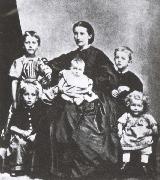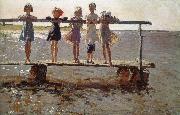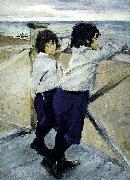Wholesale Oil Painting No Minimum |
|||||||||||
|
|
|||||||||||

|
|||||||||||
|
|
|
||||||||
Ferdinand Georg WaldmullerAustrian Romantic Painter, 1793-1865 was an Austrian painter and writer. He briefly attended the Academy of Fine Arts Vienna, however later had to finance his life by painting portraits. In 1811 he got a job as a teacher of arts for the children of Count Gyulay in Croatia. After 3 years he returned to Vienna and started to improve his skills by copying the works of old masters. Waldmeller later became interested in nature and thus started painting landscapes (genre painting). His most notable work lies in the depiction of nature, where his sense for colours and large knowledge of nature helped him to achieve masterly skills. In 1823 he made a painting of Ludwig van Beethoven. He was professor at the Academy of Fine Arts Vienna, |
||||||||
|
|
||||||||
Children
Children Painting ID:: 29341 |
mk65
1834
Oil on panel
mk65 1834 Oil on panel |
|||||||
|
|
||||||||
Edvard MunchNorwegian 1863-1944 Edvard Munch Locations Edvard Munch (pronounced , December 12, 1863 ?C January 23, 1944) was a Norwegian Symbolist painter, printmaker, and an important forerunner of expressionistic art. His best-known composition, The Scream is one of the pieces in a series titled The Frieze of Life, in which Munch explored the themes of life, love, fear, death, and melancholy. Edvard Munch was born in a rustic farmhouse in the village of Adalsbruk in Loten, Norway to Christian Munch, the son of a prominent priest. Christian was a doctor and medical officer, who married Laura Cathrine Bjølstad, a woman half his age, in 1861. Edvard had an older sister, Johanne Sophie (born 1862), and three younger siblings: Peter Andreas (born 1865), Laura Cathrine (born 1867), and Inger Marie (born 1868). Both Sophie and Edvard appear to have gotten their art talent from their mother. Edvard Munch was related to painter Jacob Munch (1776?C1839) and historian Peter Andreas Munch (1810?C1863). The family moved to Kristiania (now Oslo) in 1864 when Christian Munch was appointed medical officer at Akershus Fortress. Edvard??s mother died of tuberculosis in 1868, as did Munch's favorite sister Johanne Sophie in 1877. After their mother's death, the Munch siblings were raised by their father and by their aunt Karen. Often ill for much of the winters and kept out of school, Edvard would draw to keep himself occupied. He also received tutoring from his school mates and his aunt. Christian Munch also instructed his son in history and literature, and entertained the children with vivid ghost stories and tales of Edgar Allan Poe. Christian??s positive behavior toward his children, however, was overshadowed by his morbid pietism. Munch wrote, ??My father was temperamentally nervous and obsessively religious??to the point of psychoneurosis. From him I inherited the seeds of madness. The angles of fear, sorrow, and death stood by my side since the day I was born.?? Christian reprimanded his children by telling them that their mother was looking down from heaven and grieving over their misbehavior. The oppressive religious milieu, plus Edvard??s poor health and the vivid ghost stories, helped inspire macabre visions and nightmares in Edvard, who felt death constantly advancing on him. One of Munch's younger sisters was diagnosed with mental illness at an early age. Of the five siblings only Andreas married, but he died a few months after the wedding. Munch would later write, "I inherited two of mankind's most frightful enemies??the heritage of consumption and insanity." Christian Munch??s military pay was very low, and his attempts at developing a private side practice failed, keeping his family in perrenial poverty. They moved frequently from one sordid flat to another. Munch??s early drawings and watercolors depicted these interiors, and the individual objects such as medicine bottles and drawing implements, plus some landscapes. By his teens, art dominated Munch??s interests. At thirteen, Munch has his first exposure to other artists at the newly formed Art Association, were he admired the work of the Norwegian landscape school, and where he returned to copy the paintings, and soon he began to paint in oils. |
||||||||
|
|
||||||||
|
|
Children
Children Painting ID:: 55494 |
mk241
mk241 |
||||||
|
|
||||||||
Gustave Courbet1819-1877 French Gustave Courbet Locations was a French painter whose powerful pictures of peasants and scenes of everyday life established him as the leading figure of the realist movement of the mid-19th century. Gustave Courbet was born at Ornans on June 10, 1819. He appears to have inherited his vigorous temperament from his father, a landowner and prominent personality in the Franche-Comte region. At the age of 18 Gustave went to the College Royal at Besancon. There he openly expressed his dissatisfaction with the traditional classical subjects he was obliged to study, going so far as to lead a revolt among the students. In 1838 he was enrolled as an externe and could simultaneously attend the classes of Charles Flajoulot, director of the ecole des Beaux-Arts. At the college in Besançon, Courbet became fast friends with Max Buchon, whose Essais Poetiques (1839) he illustrated with four lithographs. In 1840 Courbet went to Paris to study law, but he decided to become a painter and spent much time copying in the Louvre. In 1844 his Self-Portrait with Black Dog was exhibited at the Salon. The following year he submitted five pictures; only one, Le Guitarrero, was accepted. After a complete rejection in 1847, the Liberal Jury of 1848 accepted all 10 of his entries, and the critic Champfleury, who was to become Courbet first staunch apologist, highly praised the Walpurgis Night. |
||||||||
|
|
||||||||
|
|
Children
Children Painting ID:: 55620 |
mk242
1856
84x51.5cm
mk242 1856 84x51.5cm |
||||||
|
|
||||||||
|
|
||||||||
|
|
Children
Children Painting ID:: 57198 |
mk253 canvas 121 x 200 cm in 1957-1960 in St. Petersburg, Russia museum mk253 canvas 121 x 200 cm in 1957-1960 in St. Petersburg, Russia museum |
||||||
|
|
||||||||
Valentin SerovRussian Impressionist Painter, 1865-1911 |
||||||||
|
|
||||||||
|
|
Children
Children Painting ID:: 60754 |
Children, 1899
Children, 1899 |
||||||
|
|
||||||||
|
Valentin Serov Russian Impressionist Painter, 1865-1911 Children Children, 1899 |
||||||||
|
|
||||||||
|
Prev Next
|
||||||||
|
|
||||||||
|
Related Paintings to Valentin Serov :. |
||||||||
|
|
||||||||
|
CONTACT US |





